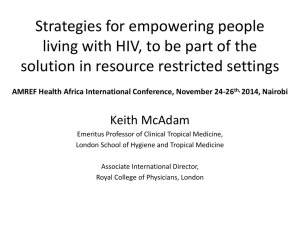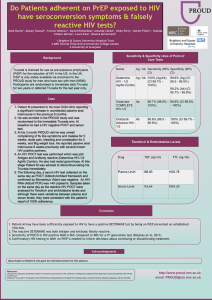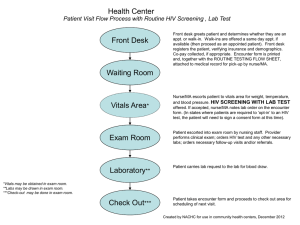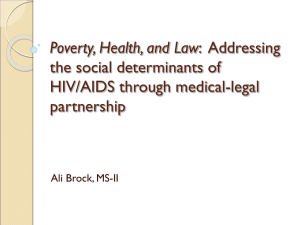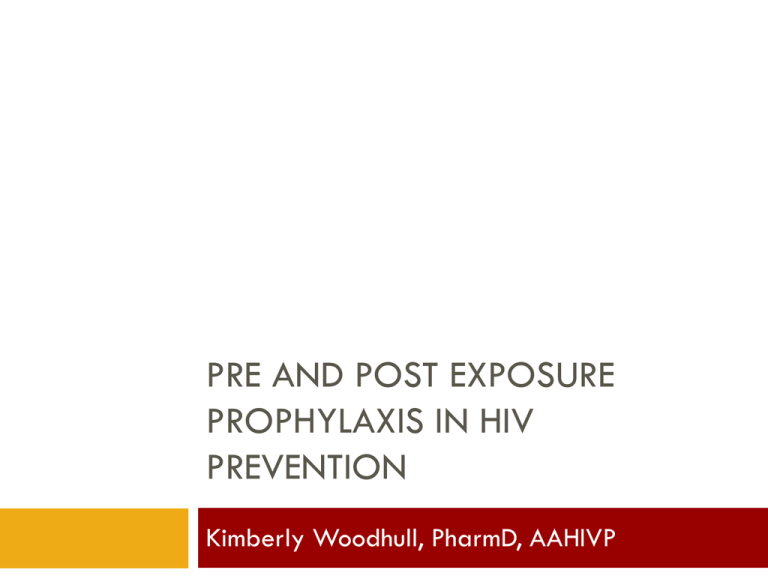
PRE AND POST EXPOSURE
PROPHYLAXIS IN HIV
PREVENTION
Kimberly Woodhull, PharmD, AAHIVP
Objectives
Understand the current guidelines for occupational
exposure prophylaxis
Select the appropriate drug regimen and duration
of treatment for post exposure prophylaxis (PEP)
Understand the need for pre-exposure prophylaxis
(PrEP)
Identify patients that are eligible for PrEP and
recommend treatment
HIV Facts
In 2008, 2.7 million new HIV infections diagnosed worldwide
1.2 million people in US with HIV
21% unaware of their status
56,000 new HIV infections in US per year
Men who have sex with men (MSM) over half of new infections
Women 27% of new infections
HIV patients will spend $600,000 for lifetime care
AIDS Facts
In 2009, estimated 34,247 people were diagnosed
with AIDS
More than 594,500 people have died of AIDS since
beginning of epidemic
~17,000 people died of AIDS in the US in 2009
Post Exposure Prophylaxis (PEP)
Percutaneous Occupational Exposures
In 2004, estimated 385,000 needlesticks/year
40-70% needlestick injuries unreported
Risk of Transmission
HIV-
0.3%
HBV-2-40%
HCV-2.7-10%
PEP 80% effective
Case –Is JR Candidate for PEP?
28 yo nurse assistant at elementary school
Stuck with needle while giving 3rd grader a
diabetes shot before lunch
Parents refusing HIV testing
Is JR candidate for PEP?
After Needle Stick Injury
Decontamination
Wash the area with soap and water
Avoid squeezing or milking the wound
Do not use caustic agents, such as bleach
Determine Risk
Type of exposure
Infection Status of Source
Decide on Treatment
Gets Labs and Follow up in 3-6 months
Post Exposure Prophylaxis for the
Healthcare Worker
Risks:
Percutaneous injury
(needlestick, cut)
With:
OR
Contact of mucous membrane
or nonintact skin
Blood
Tissue
Other body fluids that
are potentially
infectious
(cerebrospinal, semen
or vaginal secretions)
Assess Risk for HIV Infection
Type of exposure
Less severe: solid needle or superficial injury
More severe: large-bore hollow needle, deep puncture,
visible blood on device, needle used in patient’s artery or
vein
Infection status of source
Class 1: asymptomatic HIV infection or known low viral load
(<1,500 copies/mL)
Class 2: symptomatic HIV, AIDS, acute seroconversion, or
known high viral load
Initiating PEP
Start within 72 hours
2-3 drug regimen based on risk
PEP should be given for 28 days, if tolerated
PEP for Percutaneous Injuries HIV +
Source
Exposure Type
Less severe
More severe
Infection
InfectionStatus
StatusofofSource
HIV+, class 1
Recommend
basic 2-drug
PEP
Recommend
expanded 3drug PEP
Source
HIV+, class 2
Recommend
expanded ≥3drug PEP
Recommend
expanded ≥3drug PEP
PEP for Percutaneous Injuries Unknown
Source
Exposure Type
Infection
InfectionStatus
StatusofofSource
Source
Unknown HIV
status*
Unknown
source
Less severe
Generally, no PEP
warranted;
consider basic 2drug PEP if
source has HIV
risk factors
Generally, no PEP
warranted;
consider basic 2drug PEP if
exposure to HIVinfected persons
is likely
More severe
As above
As above
*If PEP started and source later determined to be HIV negative, PEP
should be discontinued.
Case –Is JR Candidate for PEP?
Exposure-Less severe
Infection source status-Unknown
Time –Within 72 hours
Treat?
However….
ER provider recommended starting PEP for 28 days:
Zidovudine/lamivudine
(Combivir®)
Indinavir (Crixivan®) or Nevirapine (Viramune®)
Guidelines for Treatment
Basic 2 Drug
Regimens:
Preferred:
ZDV
+ 3TC or FTC
TDF + 3TC or FTC
Alternative:
d4T
+ 3TC or FTC
ddI + 3TC or FTC
Expanded ≥3 drug:
Preferred:
LPV/RTV
(Kaletra) +
Alternative:
± RTV
FPV ± RTV
IDV** ± RTV
SQV + RTV
NFV***
EFV***
ATV*
* If ATV is coadmnistered with TDF, RTV must be included in the PEP regimen.
** Avoid in late pregnancy.
*** Avoid in pregnancy.
IF PEP: Recommended Regimen
Tenofovir/emtricitabine (Truvada®)
+/−
Lopinavir/ritonavir (Kaletra®)
PEP Questions
Consult Guidelines
Available
at http://www.aidsinfo.nih.gov/guidelines
National Clinician’s Postexposure Prophylaxis
Hotline (PEPline)
Telephone consultation service:
1-888-448-4911
9
am-2 am EST
JR Conclusion
JR opted not to take treatment
Child tested; negative
Recap PEP
Determine severity of risk
Source of infection
Initiate treatment within 72 hours
Treat with Truvada +/- Kaletra
Treat for 28 days
Pre Exposure Prophylaxis (PrEP)
Pre-Exposure Prophylaxis for HIV
Prevention
Antiretrovirals in HIV patients restores health and may
decrease transmission of virus to uninfected partners
HIV pill taken daily or gel applied to vagina
Tenofovir (TDF) and Truvada (FTC-TDF)
Reduce risk of HIV infection
Rationale based on:
Prevention of mother to child transmission
Post exposure prophylaxis
Animal Studies
PREP Trials Worldwide
Study 1: FHI West Africa
Phase 2, randomized, double-blind, placebo-controlled
June 2004 to March 2006
Enrolled in 3 sites: Ghada, Camerron, and Nigeria
936 HIV-negative women at high risk of HIV infection
Safety endpoints measured by
469 received TDF
467 received placebo
Serum creatinine >2.0 mg/dl
Phosphorus <1.5 mg/dl
Alanine aminotranferase elevations >170 U/I
Efficacy measured by infection of HIV-1 or HIV-2
Study 2: Preexposure Prophylaxis
Initiative (iPrEx)
Phase 3, randomized, double-blind, placebocontrolled
11 sites in six countries
July 2007-December 2009
3,324
person-years
2,499 HIV negative men or transgender women
who have sex with men
1,251
given FTC-TDF
1,248 given placebo
Study 3: CAPRISA 004
Phase II, double-blind, randomized, placebocontrolled
May 2007-March 2010
1,341
women years
889 women at high risk of HIV through intercourse
445
tenofovir gel
444 placebo gel
Efficacy Results
Data from FH1 West Africa
TDF
PersonYears of
Follow-Up
232.6
HIV
infections/10
0 personyears
0.86
Placebo
Incidence
Rate
241.3
2.48
0.35
Reduction in Risk for HIV Acquisition in
iPrEX Trial
FTC-TDF
(events)
Placebo
(events)
Hazard
Ratio
HIV Infection
36
64
0.56 (0.370.85)
Pill Use
<90%
28
34
0.79 (0.481.31)
Pill Use
≥90%
8
30
0.27 (0.120.59)
Effectiveness of tenofovir gel in HIV Prevention in CAPRISA 004
HIV Incidence/100 Women Years
Tenofovir gel
(95% CI)
Placebo gel
(95% CI)
Incidence Rate Ratio
HIV total
5.6
9.1
0.61
Gel Use >80%
4.2
9.3
0.46
Gel Use <50%
6.2
8.6
0.72
Results from TDF2 and Partners
PrEP
TDF2 Study –Reduced risk by 63%
Separate
analysis showed 78% risk reduction
Partners PrEP
62%
with Tenofovir (p=0.0003)
73% with Truvada (p<0.0001)
Conclusions
PrEP effective in HIV prevention
Adherence is critical
Used in high risk populations
PrEP should be used in combination with other
prevention methods
Questions
References
1. CDC. HIV in the United States, July 2010. Available at http;//www.cdc.gov/hiv/resources/factsheets/us.htm. Accessed Sept
2011.
2. Hall HI, Song RG, Rhodes P, et al. Estimation of HIV incidence in the United States. JAMA 2008;300:520-9.
3. Panel on treatment of HIV-infected pregnant women prevention of perinatal transmission. Recommendations for use of
antiretroviral drugs in pregnant HIV-1-infected women for use maternal health and interventions to reduce perinatal HIV
transmission in the United States. September 14, 2011. pp. 1-207. Available at:
http://aidsinfo.nih.gov/ContentFiles/PerinatalGL.pdf. Accessed Sept 2011.
4. Centers for Disease Control and Prevention. Updated U.S. Public Health Service guidelines for the management of
occupational exposures to HIV and recommendations for Postexposure Prophylaxis. MMWR 2005;54(No. RR-9). Available
at http://aidsinfo.nih.gov/contentfiles/HealthCareOccupExpoGL.pdf. Accessed Sept 2011.
5. Shih CC, Kaneshima H, Rabin L, et al. Postexposure prophylaxis with zidovudine suppresses human immunodeficiency virus
type 1 infection in SCID-hu mice in a time-dependent manner. J Infect Dis. 1991;163(3)625-7.
6. AVAC: Global Advocacy for HIV Prevention. PrEP trials Timeline. Available at: http://www.avac.org/ht/d/sp/i/3507/pid/3507.
Accessed Sept 2011.
7. Peterson, L., Tayor, D., Roddy, R., et al. Tenofovir Disoproxil Fumarate for Prevention of HIV Infection in Women: A Phase 2,
Double-Blind, Randomized, Placebo-Controlled Trial. PLOS Clinical Trials 2007:2(5):e27.
8. Grant RM, Lama JR, Anderson PL, McMahan V, Liu AY, Vargas L, et al. Preexposure Chemo-prophylaxis for HIV Prevention
in Men Who Have Sex with Men. N. Engl J Med. 2010:363:27.
9. Centers for Disease Control and Prevention. Interim Guidance: Preexposure Prophylaxis for the Prevention of HIV Infection in
Men Who Have Sex with Men. MMWR 2011;60(3):65-68.
10. Abdool Karim Q, Abdool Karim SS, Frohlich JA, et al. Effectiveness and safety of tenofovir gel, an antiretroviral microbicide,
for the prevention of HIV infection in women. Science 2010:329:1168-74.

